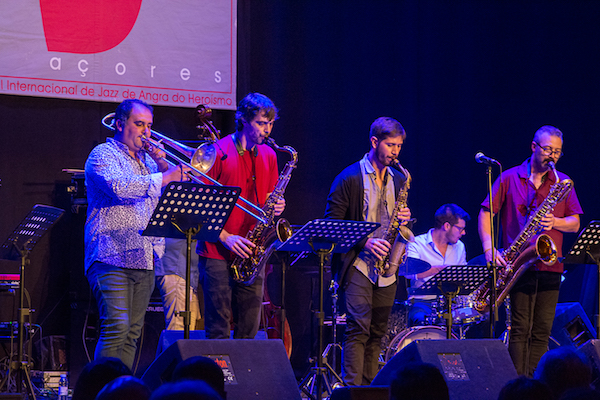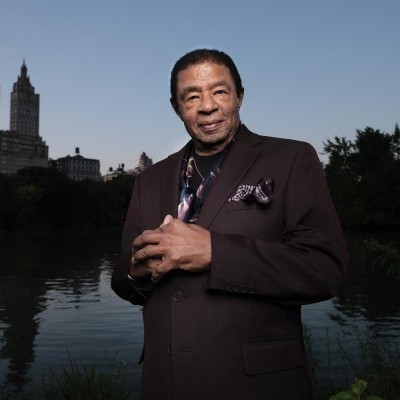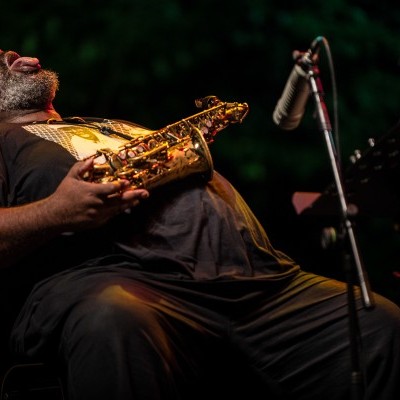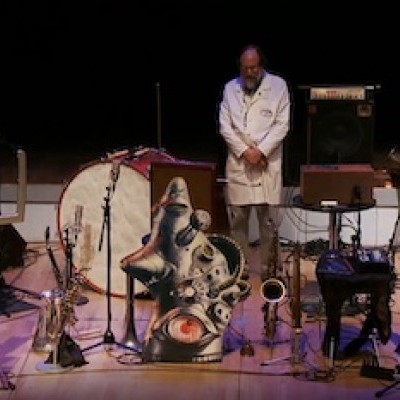Aug 26, 2025 1:53 PM
Blindfold Test: Buster Williams
Buster Williams, who at the age of 83 has been on the scene for 65 years, had never done a Blindfold Test. The first…

Members of Ensemble Super Moderne perform at the AngraJazz Festival, which ran Oct. 4–7 in Portugal.
(Photo: Jorge Monjardino)Although Portugal continues to host a number of noteworthy festivals and is the home to the envelope-pushing jazz label Clean Feed, the country’s jazz scene remains underappreciated. The 19th annual AngraJazz, held Oct. 4–7 on Terceira Island in the capital city of Angra do Heroísmo, seemed to carry a mission to rectify that issue.
Performances took place at the posh Centro Cultural e de Congressos de Angra do Heroísmo, a circular 550-seat venue that was once Praça de Toiros de São João, a coliseum that housed bull-fighting until it was destroyed by a volcanic earthquake in 1980. The space was refurbished in 2003 by lead architect Miguel Cunha, who coincidentally is one of the founders of the Angrajazz.
The island’s sizable Orquestra Angrajazz opened the four-day festival with an agreeable celebration of jazz’s bebop era. Founded in 2002 and consisting of mostly jazz artists born on Terceira, the 21-piece ensemble, co-directed by Claus Nymark and Pedro Moreira, delivered a broad program of bebop chestnuts that included “Night In Tunisia,” “Lady Bird” and “Honeysuckle Rose.” In honor of Thelonious Monk’s centennial, Orquestra Angrajazz played a fair share of Monk compositions that included “’Round Midnight,” “Epistrophy,” “I Mean You” and “Bemsha Swing.” Performance-wise, the renditions were respectable at best. Orquestra Angrajazz brimmed with potential of becoming an international force in the tradition of Germany’s WDR Jazz Big Band or Austria’s Vienna Jazz Orchestra. But for now, it’s noteworthy because of its very existence.
Much more engaging was Portugal’s Ensemble Super Moderne, a vibrant octet of exploratory musicians and composers who embraced a Third Stream approach. Its gangly set, mostly culled from its 2014 eponymously titled debut, connected dots between Charles Mingus, Gunther Schuller and Anthony Braxton with such contemporary sonic explorers as Mary Halvorson and Darcy James Argue. Beginning its set with the exploratory “La Capricciosa,” which contained spiky lines, stark harmonies and a stuttering rhythmic flow, the ensemble soon revealed more emotional depth and rounded temperament on such transportive originals as “Moderne,” which featured José Pedro Coelho’s silvery tenor saxophone riding a rubato waltz rhythm that was frequently interrupted by jagged passages.
On “The Dreary Life Of Pugnacious,” the ensemble displayed its flair for navigating intricate, ricocheting meters as well as crafting suspenseful harmonies, while the hypnotic “Regui” showed the ensemble’s fondness for reggae music. The striking compositions afforded each member the spotlight, which revealed such spectacular young mavericks as guitarist Eurico Costa, trombonist Paulo Perfeito, drummer Mário Costa, and clarinetist and baritone saxophonist Rui Teixeira as talents worth watching.
The rest of the festival boasted a small yet potent and versatile offering of superb talent that included trumpeter Charles Tolliver fronting his Tentet in “Brilliant Corners,” a bristling if uneven two-hour-plus celebration of Monk’s centennial. The ensemble was originally supposed to feature pianist Stanley Cowell, but because of illness, the venerable Kirk Lightsey filled the piano chair. Lightsey delivered a rhapsodic reading of “In Walked Bud” before bassist Devin Starks and drummer Darrell Green joined for a delightful romp through “Blue Monk.” Then tenor saxophonist Stephen Gladney joined the fray for a spunky makeover of “Rhythm-a-Ning” before the rest of the ensemble entered the sage. Using Hal Overton’s arrangements, Tolliver reprised his 2009 reenactment of Monk’s iconic 1959 Town Hall concert with such rambunctious versions of “Friday, The 13th,” “Monk’s Mood,” “Little Rootie Tootie” and “Trinkle Tinkle.”
On the other end of the sonic spectrum was the bracing duo performance from French pianist Baptiste Trotignon and Argentine percussionist Mínimo Garay. The two juxtaposed their respective virtuosity with spellbinding displays of spatial and dynamic awareness through an expansive repertoire that included “Une Petite Fille,” “La Cambiada,” “Vamos” and “La Répétition.” Garay not only powered Trotignon’s orchestral yet punchy improvisations with a superb agility among box drums, cymbals, body percussion, angle bells and other small hand percussion, he added tremendous colors and textural wonder to the music.
Matt Wilson’s quartet and Jon Irabagon’s quartet were highlights as well. With cornetist Kirk Knuffke, bassist Chris Lightcap and saxophonist and clarinetist Jeff Lederer, Wilson displayed his patented blend of vigorous modern jazz and madcap antics on a program that included “Choose” (from his latest disc, Honey And Salt), “Arts And Craft” and “Raga”—the latter featuring an extensive gong solo from Wilson. On the loopy original “Man Bun,” Wilson exhibited his awareness of hip-hop by flipping his snare drum then sawing a textural improvisation that mimicked classic turntablism. He juxtaposed those moments with touching balladry (“Dancing With Water,” featuring a splendid bass solo from Lightcap) and historical hat-tipping with a fantastic reading of Pee Wee Russell’s “Pee Wee Blues,” which featured a guest appearance from tenor saxophonist Irabagon, and “Thespian,” a feisty hard-bop piece from underappreciated figure Freddie Redd.
Irabagon, too, balanced comedic wit with formidable modern jazz with his boisterous quartet that included drummer Rudy Royston, bassist Yasushi Nakamura and pianist Luis Perdomo. The quartet showcased music from Irabagon’s forthcoming disc, Dr. Quixotic’s Traveling Exotics, with the jaunty original “Emotional Physics” recalling mid-’80s M-BASE before segueing into an elastic makeover of “All The Thing You Are,” as well as music from his 2015 disc, Behind The Sky, including the gorgeous ballad “Music Box Song (For When We’re Apart)” and the prancing title track.
It’s to the Angrajazz Festival’s credit that within its 19 years of existence, it hasn’t relied upon any pop acts to draw larger crowds. The closest the festival got to pop this year was Cuban-born, Switzerland-based violinist Yilian Cañizares, whose charisma and showmanship recall Esperanza Spalding. Her intoxicating blend of Euro-Afro-Cuban music, with sonic glimpses of Yiddish flavor, inspired the audience to respond with standing ovations and rousing cheers. DB

“What I got from Percy was the dignity of playing the bass,” Buster Williams said of Percy Heath.
Aug 26, 2025 1:53 PM
Buster Williams, who at the age of 83 has been on the scene for 65 years, had never done a Blindfold Test. The first…

Don and Maureen Sickler serve as the keepers of engineer Rudy Van Gelder’s flame at Van Gelder Studio, perhaps the most famous recording studio in jazz history.
Sep 3, 2025 12:02 PM
On the last Sunday of 2024, in the control room of Van Gelder Studio, Don and Maureen Sickler, co-owners since Rudy Van…

The Free Slave, Cosmos Nucleus and Sunset To Dawn: three classic Muse albums being reissued this fall by Timer Traveler Recordings.
Aug 26, 2025 1:32 PM
Record producer and “Jazz Detective” Zev Feldman has launched his next endeavor, the archival label Time Traveler…

This year’s Jazz em Agosto set by the Darius Jones Trio captured the titular alto saxophonist at his most ferocious.
Aug 26, 2025 1:31 PM
The organizers of Lisbon, Portugal’s Jazz em Agosto Festival assume its audience is thoughtful and independent. Over…

Trio aRT with its avalanche of instrumentation: from left, Pheeroan akLaff, Scott Robinson and Julian Thayer.
Sep 3, 2025 12:03 PM
Trio aRT, a working unit since 1988, shockingly released its very first studio recording this summer. Recorded in…